Unplugged: The Return of the Fantasy RPGs
Last time I talked about role playing games, it was a discussion of Dungeons and Dragons, including the rereleases of many old retro versions of the game and adventures as well as the upcoming revision of the game entitled “D&D Next”. When it comes to Fantasy RPGs, there are many more fishes in the sea. Today we’ll look at two of them. First, we’ll examine Hero Kids, an extremely kid-friendly title for ages as young as four. Next, we’ll look at the “other” top-tier fantasy RPG: Pathfinder, produced by Paizo Publishing – past publisher of the D&D magazines Dragon and Dungeon. While it is moderately complex in its player options, actual player combat and skill resolutions aren’t too bad. What makes the Pathfinder RPG system stand out is the large level of support materials produced by Paizo. The Game Master (the person who runs the bad guys and helps manage the story) has many available options they can use to make things easier and help create a more immersive game (eg. maps, cards, tools to manage fights, etc…).
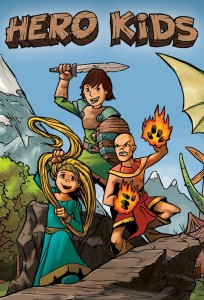 Perhaps the most basic rules set I have yet seen for fantasy RPGs, but since this is geared to younger kids (ages 4-10), this is an extremely good thing. Hero Kids focuses on the adventures of talented kids, going out to “set things right” since their parents are either busy or unable to help. The system uses 3 normal 6-sided dice to resolve almost every situation. Characters can have melee attacks, ranged attacks, magic attacks, and have some level of defense. The attacker rolls however many dice they have (usually 1 or 2, but can get up to 3) and compares their highest number to the dice rolled by the defender. If the attacker’s highest die is equal or higher to the defender’s highest die, the defender loses one hit point (usually 1 or 2 for a monster while heros typically have 3). In a great bit of kid-friendly wisdom, the designer suggests using M&Ms or other type of candy for monster and hero hit points. (Thus when you hurt a monster you get to eat an M&M, while the game master gets an M&M when they damage a hero player.)
Perhaps the most basic rules set I have yet seen for fantasy RPGs, but since this is geared to younger kids (ages 4-10), this is an extremely good thing. Hero Kids focuses on the adventures of talented kids, going out to “set things right” since their parents are either busy or unable to help. The system uses 3 normal 6-sided dice to resolve almost every situation. Characters can have melee attacks, ranged attacks, magic attacks, and have some level of defense. The attacker rolls however many dice they have (usually 1 or 2, but can get up to 3) and compares their highest number to the dice rolled by the defender. If the attacker’s highest die is equal or higher to the defender’s highest die, the defender loses one hit point (usually 1 or 2 for a monster while heros typically have 3). In a great bit of kid-friendly wisdom, the designer suggests using M&Ms or other type of candy for monster and hero hit points. (Thus when you hurt a monster you get to eat an M&M, while the game master gets an M&M when they damage a hero player.)
My favorite part about the system (other than the simplicity, which allows me to play with my two sons – preschool & 1st grade) are the very well “packaged” scenarios which are also available. Each module contains a walkthrough of encounters and flavor text (typically not very complicated story lines.) However, there are also maps to print out of nearly every important area, laid out with a handy combat grid. Along with every creature or monster encountered in the module is a paper miniature. Print out the paper mini, fold it in half, and tape a coin on the bottom and you have an instant “miniature” to use in the game – extremely handy to help young kids more immersed in the game.
Now, how much would you pay for all this? Well, the price certainly is right. Since everything is available as a PDF file, $6 gets you the rules and a short adventure module. $6 more and you can pick up 3 more modules. However, I recommend going either with $10 for a pile of stuff (rules and 4 more adventures) or just go whole hog and get everything available for $15 (rules, 7 adventures, some extra stuff). That’s cheaper than taking two kids out to a movie! You can find the all these PDFs at the premier RPG web store: RPG Now.
Now go have fun playing with your kids face to face instead of everyone staring at a screen! It is great for improving creativity and imagination (yours AND theirs!)
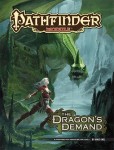 Recall that D&D has gone through several iterations, two of the most recent include the 3.0 edition followed by an “upgrade” to 3.5. A few years later, the current 4th edition was announced with a decidedly mixed response. Version 3.5 had developed into a far-ranging panoply of options for players to customize their personal character. The new edition threatened to move in a direction that catered to players of online RPGs like World of Warcraft, etc… Classes and monsters were to be carefully balanced both for combat ability but also for general “tricks” and “fun abilities”. Of course, there was also everyone’s biggest fear – CHANGE! What to do? In steps Paizo publishing. For many years they were producing the two D&D fan magazines Dragon and Dungeon. With the release of 4th edition, those magazines were going back “in house” and produced by Wizards of the Coast. The 3.5 (and 3.0) edition of the D&D rules were revolutionary in that they had a partially “Open License”. The core rules behind the game could be used to create other modules, adventures, even role playing games in entirely new genres. Paizo took advantage of that fact and produced (with plenty of fan input) their own version of D&D entitled Pathfinder. They attempted to fix up bits of the “old” 3.5 edition rules, such as strange rules and unbalanced character options. As such, fans of Pathfinder with now frequently call it D&D 3.75.
Recall that D&D has gone through several iterations, two of the most recent include the 3.0 edition followed by an “upgrade” to 3.5. A few years later, the current 4th edition was announced with a decidedly mixed response. Version 3.5 had developed into a far-ranging panoply of options for players to customize their personal character. The new edition threatened to move in a direction that catered to players of online RPGs like World of Warcraft, etc… Classes and monsters were to be carefully balanced both for combat ability but also for general “tricks” and “fun abilities”. Of course, there was also everyone’s biggest fear – CHANGE! What to do? In steps Paizo publishing. For many years they were producing the two D&D fan magazines Dragon and Dungeon. With the release of 4th edition, those magazines were going back “in house” and produced by Wizards of the Coast. The 3.5 (and 3.0) edition of the D&D rules were revolutionary in that they had a partially “Open License”. The core rules behind the game could be used to create other modules, adventures, even role playing games in entirely new genres. Paizo took advantage of that fact and produced (with plenty of fan input) their own version of D&D entitled Pathfinder. They attempted to fix up bits of the “old” 3.5 edition rules, such as strange rules and unbalanced character options. As such, fans of Pathfinder with now frequently call it D&D 3.75.
What stands out to me the most about Paizo’s Pathfinder system, is the level of support they provide the game to help create a more immersive environment for players. Rather than simply provide the basic rules and then crank out adventures and additional player supplements, they’ve managed to also add in products that cater to gamers who have a bit more money than time. Paizo sells Map Packs of cardstock tiles that can be laid out to form large encounter areas such as mausoleums, temples, graveyards, even one set of tiles for various monsters that may have swallowed a character whole! Other options include Flip-Mats which are larger double-sided maps coated in plastic so that even permanent marker can be wiped off, if necessary. They produce a Combat Pad to help keep track of everything that might happen in combat, and then they have their cards. Paizo has a whole line of decks of cards that help manage game rules or help players become more immersed in the game experience. Many of their adventure lines have a deck of cards that represent important magic items present in the module. There are decks of cards to help resolve critical failures (rolling a 1), critical hits (rolling a 20), cards that denote a particular condition (dazed, stunned, blind, etc…) as well as a set for common “buffs” – spells that can be applied on other player’s to increase their abilities.
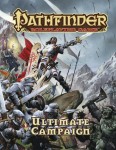 To get a feel for their product line, lets take a look at three of Paizo’s newer releases. Last spring they released the book: Ultimate Campaign. This book is split between three main areas. The first area consists of player options for their characters and provides a wealth of new ways characters can flesh out their backgrounds to better tie in to the Pathfinder setting as a whole. The second section has several sets of optional rules to better emphasize the non-combat side of the game. Included are rules for monitoring players’ honor, rules for haggling, and a set of rules for creating and maintaining a set of contacts for gathering information. The final section is devoted to large-scale ideas – suitable for players who have progressed to high levels and are now having to deal with society on the highest levels. This section includes how to build up small kingdoms (or simple forts) as well as rules for dealing with mass combat (rather than being reduced to trying to recreate a battle via individual soldiers – something for which the rules system is not particularly suited.) The Ultimate Campaign is a pretty decent book, and can be fairly easily used with any other fantasy themed role playing rules set.
To get a feel for their product line, lets take a look at three of Paizo’s newer releases. Last spring they released the book: Ultimate Campaign. This book is split between three main areas. The first area consists of player options for their characters and provides a wealth of new ways characters can flesh out their backgrounds to better tie in to the Pathfinder setting as a whole. The second section has several sets of optional rules to better emphasize the non-combat side of the game. Included are rules for monitoring players’ honor, rules for haggling, and a set of rules for creating and maintaining a set of contacts for gathering information. The final section is devoted to large-scale ideas – suitable for players who have progressed to high levels and are now having to deal with society on the highest levels. This section includes how to build up small kingdoms (or simple forts) as well as rules for dealing with mass combat (rather than being reduced to trying to recreate a battle via individual soldiers – something for which the rules system is not particularly suited.) The Ultimate Campaign is a pretty decent book, and can be fairly easily used with any other fantasy themed role playing rules set.
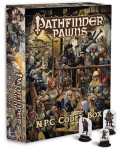 Another recent release is the NPC Codex. This is simply a book of non-player characters made using the Pathfinder rules and are suitable to use when designing encounter for your players. “Simply” is a misnomer, though, as each character has a full page description, including background information, and there are 250 different NPCs in the book. In fact, there is an NPC for each level (from 1 to 20) for each of the core classes in the Pathfinder game. For those folks who don’t want to spend money on little miniatures but still want something nice to use on their table, there is a NPC Codex Box. This box contains cardboard figures (with interchangeable plastic stands) for every NPC in the book. While I find the NPC Codex Box not nearly as useful as the Bestiary Box (tokens for piles of different monsters) it would still be very handy for anyone intending to frequently use the NPC Codex.
Another recent release is the NPC Codex. This is simply a book of non-player characters made using the Pathfinder rules and are suitable to use when designing encounter for your players. “Simply” is a misnomer, though, as each character has a full page description, including background information, and there are 250 different NPCs in the book. In fact, there is an NPC for each level (from 1 to 20) for each of the core classes in the Pathfinder game. For those folks who don’t want to spend money on little miniatures but still want something nice to use on their table, there is a NPC Codex Box. This box contains cardboard figures (with interchangeable plastic stands) for every NPC in the book. While I find the NPC Codex Box not nearly as useful as the Bestiary Box (tokens for piles of different monsters) it would still be very handy for anyone intending to frequently use the NPC Codex.
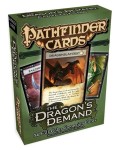 The final recent product I found rather interesting was a new adventure entitled Dragon’s Demand ($25 for the book, or $18 for the PDF). It is a new “big” style of module, spanning 64 pages, and takes characters from level 1 up through level 7 climaxing in a grand battle with a large dragon. (Some might say it may go overboard trying to speed up the leveling in time to battle the dragon, but others will enjoy the wild ride.) The module also comes with a nice, color poster map with the characters’ base (Belhaim) on one side and an encounter map on the other.
The final recent product I found rather interesting was a new adventure entitled Dragon’s Demand ($25 for the book, or $18 for the PDF). It is a new “big” style of module, spanning 64 pages, and takes characters from level 1 up through level 7 climaxing in a grand battle with a large dragon. (Some might say it may go overboard trying to speed up the leveling in time to battle the dragon, but others will enjoy the wild ride.) The module also comes with a nice, color poster map with the characters’ base (Belhaim) on one side and an encounter map on the other.
Of course, this wouldn’t be Paizo if there wasn’t additional (optional) supporting material available. There’s a new style of campaign cards available ($11). Rather than simply a deck of common magic items, this deck of cards also include drawings of the faces of important NPCs in the story and cards representing quests that remind players of what they’ve accomplished and what tasks they have yet to perform.
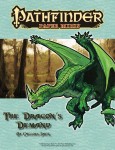 Finally, there’s the Dragon’s Demand Paper Minis ($6). Somewhat common in RPGs nowadays, paper minis are PDFs that can be printed on one side of a piece of paper (preferably cardstock), cut out and then folded over (so that both sides have a picture). The minis then have a “base” that is folded outwards from the bottom of the image and is typically taped to a coin to help it stand up. The Paizo paper minis are designed to be cut out with x-acto knives, which is a bit of a bother, but it does give them a bit more class. The Dragon’s Demand paper minis set includes over 100 different miniatures (just print more out if you want duplicates) and covers pretty much any monster or other character you might meet in the game.
Finally, there’s the Dragon’s Demand Paper Minis ($6). Somewhat common in RPGs nowadays, paper minis are PDFs that can be printed on one side of a piece of paper (preferably cardstock), cut out and then folded over (so that both sides have a picture). The minis then have a “base” that is folded outwards from the bottom of the image and is typically taped to a coin to help it stand up. The Paizo paper minis are designed to be cut out with x-acto knives, which is a bit of a bother, but it does give them a bit more class. The Dragon’s Demand paper minis set includes over 100 different miniatures (just print more out if you want duplicates) and covers pretty much any monster or other character you might meet in the game.
Sure, if you buy all three bits of the module, you’re dropping $42 at a time. However, its something that will entertain you and 4-5 friends for at LEAST six solid evenings of fun (that’s about $1/night per person.) In my opinion, it is worth it to spring for the “extras” (if you’re willing to put in a bit of hobby time taping together the minis) simply because it will make the adventure much more immersive for the players.
The Pathfinder RPG continues to be a very popular system. Locally, it is even easier to find groups playing Pathfinder than to find groups using the current, 4th Edition of Dungeons and Dragons. While the main rules are a bit complicated to learn if no one in your group knows them, they provide some of the most diverse options around for players to develop their characters. For those looking to just dip their toe into the Pathfinder waters, I would recommend the Pathfinder Beginner Box, complete with pre-made characters, easy start rules with a small adventure, and even stand-up cardboard tokens like those found in the NPC Codex box and Bestiary box. It remains to be seen whether this upcoming version, “D&D Next” will be able to unseat Paizo’s current standing as the fantasy RPG choice for more experienced players.

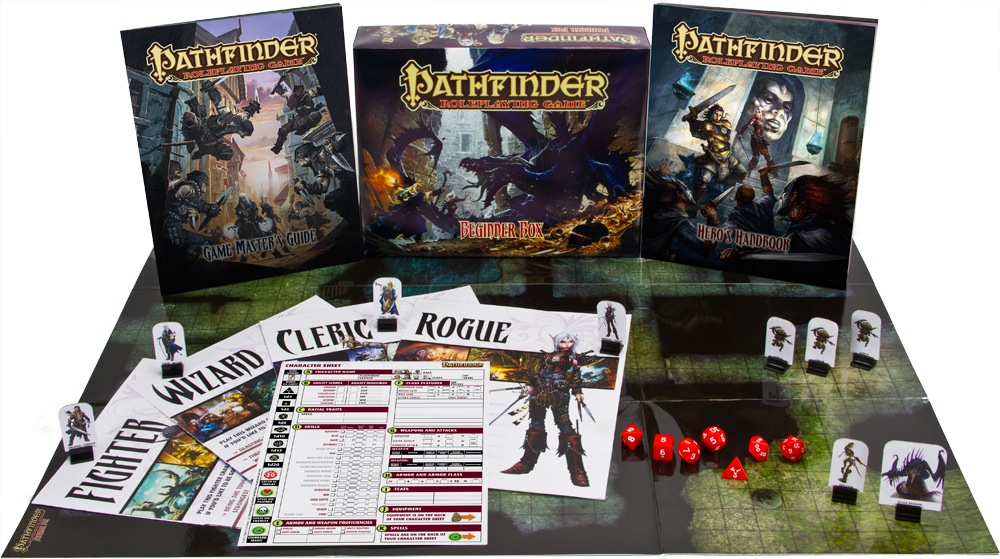




Discussion Area - Leave a Comment